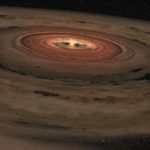Small Body Group (even smaller than dwarf-planets / planetoids; these are so small, they are not even planetoids or moons)
Mass: < 0.0001 Earth; not massive enough to sustain hydrostatic equilibrium.
Sizes: typically 3 meters to 20+ km across
–
Vulcanoidal:
Composition: rocky.
Orbit: epi-stellar.
Content: high metallic.
Note: Rare, even unique mineralogical properties may develop because of long term exposure (over 2+ billion years) to intense stellar radiation.
Asteroidal:
Composition: archetypal asteroids.
Composition: archetypal asteroids.
Size: small, irregular bodies.
Orbit: often in specific belts / fields in a solar system, may be in eccentric solar orbits.
Orbit: often in specific belts / fields in a solar system, may be in eccentric solar orbits.
- Metallic:
Abundance / Rich in: metal.
Composition: dense, 50+% metallic.
Note: In most systems, are least common asteroidal bodies.
Note: In most systems, are least common asteroidal bodies.
- Silicaceous:
Abundance / Rich in: silicate.
Composition: 50+% silicate.
Note: fairly common inmost solar systems.
Note: fairly common inmost solar systems.
- Carbonaceous:
Abundance / Rich in: carbon.
Composition: varying amounts of silicates and metals.
Note: by far the most common type of asteroidal in most systems.
Note: by far the most common type of asteroidal in most systems.
- Gelidaceous:
Abundance / Rich in: ice.
Composition: 50+% frozen volatiles.
Note: Unlike the Cometary Class, these are in stable, relatively circular orbits which do not take them close enough to the local star for volatile-loss.
Note: Unlike the Cometary Class, these are in stable, relatively circular orbits which do not take them close enough to the local star for volatile-loss.
- Aggregate:
Note: debris piles, held together by mutual gravity; forms may change over time, subtly or obviously, due to gravitational flexing.
Composition: may vary, but for the most part tend to be silicate-rich.
Cometary – comets,
Composition: 50+% ice.
Composition: 50+% ice.
Orbit: can carry them relatively close to their star, causing volatile depletion and out-gassing.
- Passive:
Note: dormant.
Orbit: distant stellar, or are in the slow process of having them transformed to take them close to the stellar primary.
Oort:
Orbit: outermost regions of their star’s gravity well, typically: Oort cloud.
Orbit: outermost regions of their star’s gravity well, typically: Oort cloud.
Note: nearly unchanged since their formation.
Kuiper:
Orbit: Kuiper belt.
Note: remain relatively unchanged since the time of their formation.
Orbit: Kuiper belt.
Note: remain relatively unchanged since the time of their formation.
Centaur:
Note: gravitationally ejected from Oort cloud /Kuiper belt, in outer planetary region of the system.
Note: gravitationally ejected from Oort cloud /Kuiper belt, in outer planetary region of the system.
Orbit: gravitationally unstable, will likely become Active Type comets.
- Active:
Orbit: takes them fairly close to their stellar primary, resulting in volatile loss;
classical comets.
Active-Brevis:
Note: active bodies.
Active-Brevis:
Note: active bodies.
Orbit: < 200 Earth years, gravitationally bound to their stellar primary, may be subject to shifting orbits over 200+ million years.
Active-Dirunitus:
Note: active bodies.
Active-Dirunitus:
Note: active bodies.
Orbit: > 200 Earth years, gravitationally bound to the primary star.
Active-Effigia:
Orbit: parabolic /hyperbolic; pass close to their/a star once, and are then flung out of the solar system forever.
Active-Effigia:
Orbit: parabolic /hyperbolic; pass close to their/a star once, and are then flung out of the solar system forever.
- Damocloid:
Note: lost all of their volatiles.
Appear: quite similar to asteroids.
Age: typically quite ancient, although some are of average age, but have been trapped within very short-period orbits for most of their active lifetimes.
Age: typically quite ancient, although some are of average age, but have been trapped within very short-period orbits for most of their active lifetimes.
–
video



